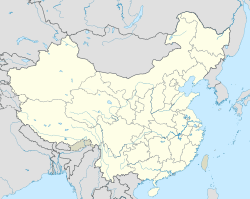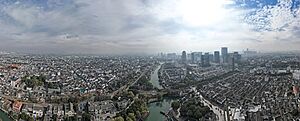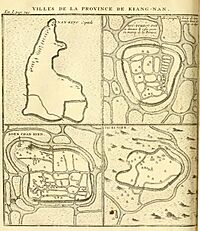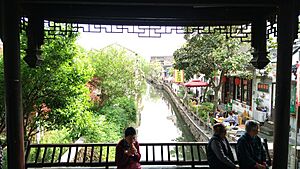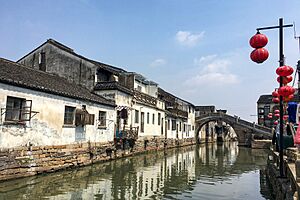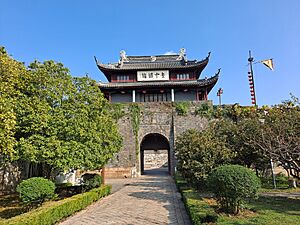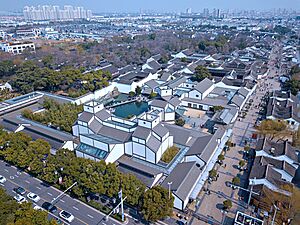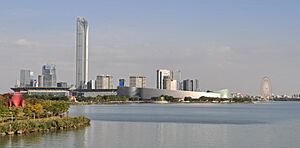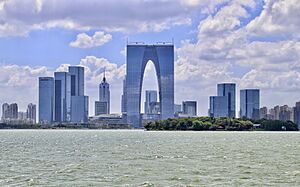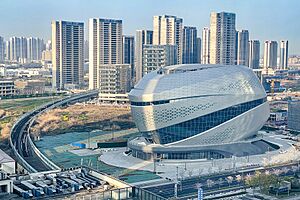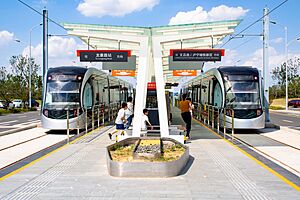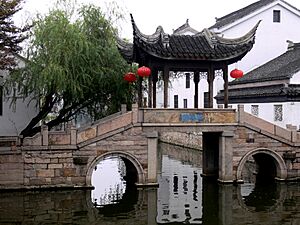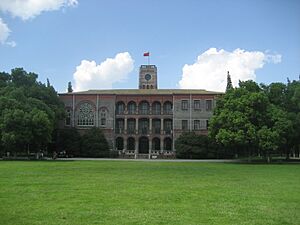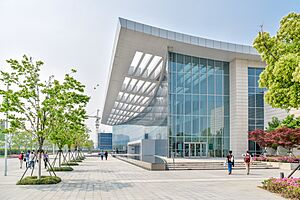Suzhou facts for kids
Quick facts for kids
Suzhou
苏州市
Soochow, Sou-tseu
|
|
|---|---|
|
Prefecture-level city
|
|
|
Gate to the East at Suzhou Industrial Park
Zhouzhuang Town
Garden of Cultivation
Suzhou HSR New Town
Lingering Garden
|
|
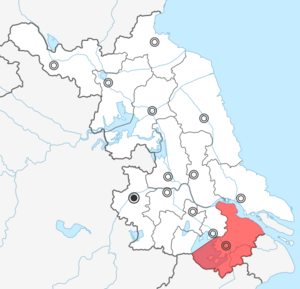
Location of Suzhou in Jiangsu
|
|
| Country | People's Republic of China |
| Province | Jiangsu |
| County-level divisions | 11 |
| Established | 514 BC |
| Municipal seat | Gusu District |
| Government | |
| • Type | Prefecture-level city |
| Area | |
| • Prefecture-level city | 8,488.42 km2 (3,277.40 sq mi) |
| • Land | 5,851 km2 (2,259 sq mi) |
| • Water | 2,394.50 km2 (924.52 sq mi) |
| • Urban | 2,944.4 km2 (1,136.8 sq mi) |
| • Metro | 12,493 km2 (4,824 sq mi) |
| Population
(2020 census)
|
|
| • Prefecture-level city | 12,748,252 |
| • Density | 1,501.8404/km2 (3,889.7488/sq mi) |
| • Urban | 6,715,559 |
| • Urban density | 2,280.79/km2 (5,907.22/sq mi) |
| Demonym(s) | Suzhounese |
| GDP | |
| • Prefecture-level city | CN¥ 2.272 trillion US$ 352.2 billion |
| • Per capita | CN¥ 178,207 US$ 27,629 |
| Time zone | UTC+8 (Beijing Time) |
| Postal code |
215000
|
| Area code(s) | 512 |
| ISO 3166 code | CN-JS-05 |
| HDI (2015) | 0.868– very high |
| City flower | Osmanthus |
| City tree | Camphor laurel |
| Regional dialect | Wu: Suzhou dialect |
| License plate prefix | 苏E and 苏U |
| Suzhou | |||||||||||||||||||||||||||||||
|---|---|---|---|---|---|---|---|---|---|---|---|---|---|---|---|---|---|---|---|---|---|---|---|---|---|---|---|---|---|---|---|

"Suzhou" in Simplified (top) and Traditional (bottom) Chinese characters
|
|||||||||||||||||||||||||||||||
| Simplified Chinese | 苏州 | ||||||||||||||||||||||||||||||
| Traditional Chinese | 蘇州 | ||||||||||||||||||||||||||||||
|
|||||||||||||||||||||||||||||||
Suzhou is a big city in southern Jiangsu province, China. It is part of the Yangtze Delta area, which is a huge group of cities. Suzhou is a major center for business, trade, and money.
The city was founded in 514 BC. It grew quickly, especially during the Eastern Han dynasty. This was because many people moved there from northern China. From the 10th century, Suzhou became a very important place for business and culture. For a long time, it was the largest city in the world that was not a capital city. Then, Shanghai grew even bigger.
Since China started economic reforms in 1978, Suzhou has grown a lot. Its economy has increased by about 14% each year for 35 years. In 2023, about 5 million people were officially registered as living in Suzhou. The city is also known for its scientific research. It is home to several universities, including Soochow University.
Suzhou is famous for its beautiful canals, old stone bridges, tall pagodas, and peaceful gardens. The Classical Gardens of Suzhou are so special that UNESCO added them to its World Heritage Site list in 1997 and 2000.
Contents
- Understanding Suzhou's Names
- A Look at Suzhou's Past
- How Suzhou is Organized
- Suzhou's Location and Weather
- Suzhou's Beautiful Cityscape and Environment
- Classical Gardens of Suzhou: A World Heritage Site
- Temples: Places of Worship and History
- Canals and Historic Districts: Suzhou's Waterways
- Skyscrapers: Modern Towers in Suzhou
- Pan Gate: An Ancient City Gate
- Baodai Bridge: A Historic Stone Bridge
- Tiger Hill: A Famous Tourist Spot
- Pagodas: Tall Towers of Suzhou
- Museums: Learning About Suzhou's Culture
- Hospitals: Healthcare in Suzhou
- Suzhou's People and Languages
- Suzhou's Economy: How the City Makes Money
- Development Zones: Modern Growth Areas
- Sports in Suzhou
- Getting Around Suzhou: Transportation
- Suzhou's Rich Culture
- Famous People from Suzhou
- Education in Suzhou
- See also
Understanding Suzhou's Names
During the Zhou dynasty, there was a settlement called Gusu. It was named after a nearby mountain, Mount Gusu. This place became the capital of the ancient state of Wu. Because of this, it was also called Wu.
In 514 BC, King Helü of Wu built a new capital nearby. He named it Helü City after himself. This city eventually grew into modern Suzhou. Later, it was known as Wuxian (meaning "Wu County") and Wujun ("Wu Commandery"). Under the Qin, it was called Kuaiji.
The name "Suzhou" was first used officially in AD 589, during the Sui dynasty. The "Su" part comes from the old name Gusu. It means "Satisfied place" in the old Yue language. The "zhou" part originally meant a type of province or county. But it often came to mean the main city of that region. Suzhou is the modern way to spell the name in English. Before this, it was spelled in different ways, like Soo-chow or Suchow.
A Look at Suzhou's Past
Suzhou is one of the oldest cities in the Yangtze area. It is considered the birthplace of Wu culture. Long ago, during the Spring and Autumn period, local tribes called the Gou Wu lived here. They built villages on hills near the wetlands around Lake Tai.
Ancient records say that the Zhou lord Wu Taibo started the state of Wu near Wuxi around 11th century BC. He helped the local people with farming and irrigation. The Wu court later moved to Gusu, which is now part of Suzhou. In 514 BC, King Helü of Wu moved his court again. He named the new settlement Helü City. His minister Wu Zixu helped plan this city, which became today's Suzhou.
In 473 BC, another kingdom called Yue defeated Wu. Later, Chu took over Yue in 306 BC. You can still see parts of the old city wall from 2,500 years ago. There is also a gate called Pan Gate.
The city was first planned like a grid, with the royal palace in the middle.
During the Warring States period, Suzhou was the main city for Wu County and Wu Commandery. When the Qin Empire took over in 222 BC, it became the capital of Kuaiji Commandery.
When the Grand Canal was finished, Suzhou became very important for trade. It was a major center for business and foreign trade in southeastern China. During the Tang dynasty, a famous poet named Bai Juyi built the Shantang Canal. This canal connected the city to Tiger Hill for visitors. In AD 1035, the Suzhou Confucian Temple was built. It was a place for important government exams. Later, it became the modern Suzhou High School.
In 1356, Suzhou became the capital for a leader named Zhang Shicheng. But in 1367, Zhu Yuanzhang took the city after a long fight. Zhu, who would soon start the Ming dynasty, tore down parts of the city walls. He also made the city's rich families pay very high taxes.
Even with high taxes, Suzhou soon became rich again. During the early Ming period, Suzhou was a huge source of tax money for the country.
In 1488, a Korean official named Choe Bu visited Suzhou. He wrote that it was better than any other city he saw. Under the Ming, Suzhou was a busy center. Important officials built the most famous private gardens here. These gardens had a special "Jiangnan style."
After the Qing took over in 1644, Suzhou became part of Jiangnan Province. The Taipings captured the city in 1860. Many buildings and gardens were destroyed. But by 1880, the city's population grew back to about 500,000 people.
In the late 1800s, Suzhou was known for its many kinds of silks. It also had a big Chinese publishing industry. The city was opened to foreign trade in 1895. A European-and-Chinese school opened in 1900. The Suzhou railway station, connecting to Shanghai, opened in 1906. Before World War I, there were many silk factories and a big rice trade.
In the early 1900s, much of Suzhou was made of islands. Rivers and canals connected them to the countryside. The city walls were about 10 miles long. The Japanese invaded in 1937. Many gardens were damaged again by the end of the war. In the 1950s, famous gardens like the Humble Administrator's Garden were repaired.
How Suzhou is Organized
The main part of Suzhou, called Gusu District, is often called the "Old Town." To the east is the Suzhou Industrial Park. To the west is the Suzhou High & New Technology Development Zone.
In 2000, the original Wu County was split into two districts: Xiangcheng and Wuzhong. These are now the northern and southern parts of Suzhou. In 2012, Wujiang City became Wujiang District of Suzhou.
Suzhou is one of the richest cities in China. Its growth is linked to its nearby "satellite cities." These include Kunshan, Taicang, Changshu, and Zhangjiagang. Together with Suzhou, they form the Suzhou prefecture. Many high-tech companies are located in this area.
| Map | |||||
|---|---|---|---|---|---|
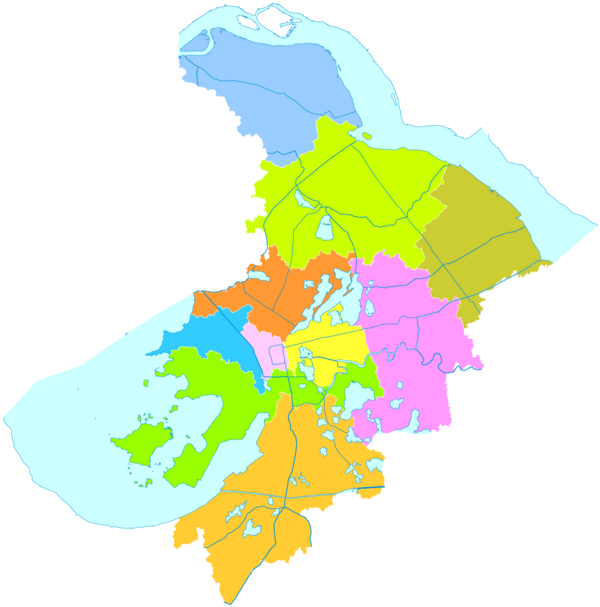
Huqiu
Wuzhong
Xiangcheng
Gusu
Wujiang
Changshu
(city) Zhangjiagang
(city) Kunshan
(city) Taicang
(city) Suzhou
Industrial Park Lake Tai
|
|||||
| Subdivision | Simplified Chinese | Hanyu Pinyin | Population (2020) | Area (km2) | Density (/km2) |
| City Proper | |||||
| Gusu District | 姑苏区 | Gūsū Qū | 2,058,010 | 372 | 5,532.28 |
| Suburban | |||||
| Huqiu District | 虎丘区 | Hǔqiū Qū | 832,499 | 258 | 3,226.74 |
| Wuzhong District | 吴中区 | Wúzhōng Qū | 1,388,972 | 672 | 2,066.92 |
| Xiangcheng District | 相城区 | Xiāngchéng Qū | 891,055 | 416 | 2,141.95 |
| Wujiang District | 吴江区 | Wújiāng Qū | 1,545,023 | 1,093 | 1,413.56 |
| Satellite cities (County-level cities) | |||||
| Changshu City | 常熟市 | Chángshú Shì | 1,677,050 | 1,094 | 1,532.95 |
| Taicang City | 太仓市 | Tàicāng Shì | 831,113 | 620 | 1,340.50 |
| Kunshan City | 昆山市 | Kūnshān Shì | 2,092,496 | 865 | 2,419.07 |
| Zhangjiagang City | 张家港市 | Zhāngjiāgǎng Shì | 1,432,044 | 772 | 1,854.97 |
| Total | 12,748,252 | 8,488 | 1,501.84 | ||
| Not formal administrative subdivisions – Suzhou Industrial Park & Suzhou New District Defunct districts – Canglang District, Pingjiang District, & Jinchang District |
|||||
Suzhou's Location and Weather
Suzhou is located on the Lake Tai Plain. This is south of the Yangtze River. It is about 100 km (62 mi) west of Shanghai. It is also just over 200 km (124 mi) east of Nanjing.
Suzhou's Climate: What's the Weather Like?
Suzhou has a humid subtropical climate. This means it has four seasons. Summers are hot and humid. Winters are cool, cloudy, and damp. Sometimes it snows.
Winds from Siberia in winter can make temperatures drop below freezing at night. In summer, winds from the south can push temperatures above 35°C (95°F). The hottest temperature ever recorded was 41.0°C (105.8°F) in August 2013. The coldest was -9.8°C (14.4°F) in January 1958.
| Climate data for Suzhou (Wuzhong District) (1991–2020 normals, extremes 1951–present) | |||||||||||||
|---|---|---|---|---|---|---|---|---|---|---|---|---|---|
| Month | Jan | Feb | Mar | Apr | May | Jun | Jul | Aug | Sep | Oct | Nov | Dec | Year |
| Record high °C (°F) | 22.5 (72.5) |
28.0 (82.4) |
31.9 (89.4) |
33.6 (92.5) |
35.8 (96.4) |
37.3 (99.1) |
39.7 (103.5) |
41.0 (105.8) |
37.4 (99.3) |
33.1 (91.6) |
27.2 (81.0) |
24.5 (76.1) |
41.0 (105.8) |
| Mean daily maximum °C (°F) | 8.4 (47.1) |
10.4 (50.7) |
15.2 (59.4) |
21.1 (70.0) |
26.1 (79.0) |
28.7 (83.7) |
33.0 (91.4) |
32.6 (90.7) |
28.4 (83.1) |
23.4 (74.1) |
17.4 (63.3) |
10.8 (51.4) |
21.3 (70.3) |
| Daily mean °C (°F) | 4.9 (40.8) |
6.4 (43.5) |
10.7 (51.3) |
16.3 (61.3) |
21.5 (70.7) |
24.9 (76.8) |
29.1 (84.4) |
28.8 (83.8) |
24.7 (76.5) |
19.5 (67.1) |
13.4 (56.1) |
7.0 (44.6) |
17.3 (63.1) |
| Mean daily minimum °C (°F) | 2.1 (35.8) |
3.4 (38.1) |
7.2 (45.0) |
12.5 (54.5) |
17.9 (64.2) |
22.0 (71.6) |
26.1 (79.0) |
26.0 (78.8) |
21.9 (71.4) |
16.3 (61.3) |
10.2 (50.4) |
4.0 (39.2) |
14.1 (57.4) |
| Record low °C (°F) | −9.8 (14.4) |
−6.6 (20.1) |
−3.7 (25.3) |
−0.5 (31.1) |
7.3 (45.1) |
13.3 (55.9) |
18.4 (65.1) |
18.6 (65.5) |
11.7 (53.1) |
2.8 (37.0) |
−2.2 (28.0) |
−8.5 (16.7) |
−9.8 (14.4) |
| Average precipitation mm (inches) | 98.8 (3.89) |
95.3 (3.75) |
129.3 (5.09) |
119.6 (4.71) |
92.5 (3.64) |
162.1 (6.38) |
92.1 (3.63) |
112.6 (4.43) |
122.3 (4.81) |
123.1 (4.85) |
94.9 (3.74) |
88.6 (3.49) |
1,331.2 (52.41) |
| Average precipitation days (≥ 0.1 mm) | 11.2 | 10.8 | 13.8 | 11.3 | 11.0 | 13.9 | 11.1 | 11.8 | 10.9 | 8.6 | 8.8 | 8.6 | 131.8 |
| Average snowy days | 2.7 | 1.9 | 0.4 | 0 | 0 | 0 | 0 | 0 | 0 | 0 | 0.2 | 0.8 | 6 |
| Average relative humidity (%) | 74 | 74 | 72 | 70 | 69 | 79 | 77 | 77 | 75 | 71 | 73 | 71 | 74 |
| Average dew point °C (°F) | 1.7 (35.1) |
2.7 (36.9) |
6.1 (43.0) |
11.2 (52.2) |
15.6 (60.1) |
21.4 (70.5) |
25.2 (77.4) |
25.0 (77.0) |
20.4 (68.7) |
14.1 (57.4) |
8.7 (47.7) |
2.1 (35.8) |
12.8 (55.2) |
| Mean monthly sunshine hours | 108.8 | 111.5 | 139.0 | 162.0 | 166.1 | 120.5 | 192.4 | 190.4 | 154.5 | 147.3 | 127.7 | 127.2 | 1,747.4 |
| Percent possible sunshine | 34 | 36 | 37 | 42 | 39 | 29 | 45 | 47 | 42 | 42 | 41 | 41 | 40 |
| Source: China Meteorological Administration | |||||||||||||
Suzhou's Beautiful Cityscape and Environment
Classical Gardens of Suzhou: A World Heritage Site
Suzhou is famous for its more than 60 Classical Gardens. These gardens are so special that they are a UNESCO World Heritage Site. Suzhou has the most UNESCO-recognized gardens in the world.
The Humble Administrator's Garden and Lingering Garden are among the four most famous classical gardens in all of China. The Canglang Pavilion, Lion Grove Garden, Humble Administrator's Garden, and Lingering Garden show different styles of traditional garden design. They are called the four most famous gardens in Suzhou.
Other gardens on the World Heritage List include the Couple's Retreat Garden, the Garden of Cultivation, and the Retreat and Reflection Garden. The Five Peaks Garden is also in Suzhou. It dates back to the Ming dynasty (1522–1566).
Temples: Places of Worship and History
Suzhou is home to several important temples:
- Hanshan Temple
- Xiyuan Temple
- Xuanmiao Temple
- Lingyanshan Temple
- Chongyuan Temple
Canals and Historic Districts: Suzhou's Waterways
The Suzhou part of the Grand Canal (China) is called the Jiangnan Canal. It has ten city gates and over 20 old stone bridges. There are also temples and pavilions. These historic areas have been kept very well.
Suzhou has 24 waterways near the Grand Canal.
In 2015, two old streets were added to China's "National Historic and Cultural Streets" list. These are the 800-year-old Pingjiang Road Historical Block and the 1,200-year-old Shantang Street Scenic Area.
Pingjiang Road runs next to the Pingjiang River for 1.5 kilometers. It has old homes and teahouses. Shantang Street is longer, at 3.8 km. It still has the charm of an old canal-side street. White buildings have red lanterns that sway in the wind.
You can take boat tours on Suzhou's waterways. This is why Marco Polo called it the "Venice of the East." The Grand Canal, which goes from Beijing to Zhejiang province, is a UNESCO World Heritage Site.
Skyscrapers: Modern Towers in Suzhou
The Gate to the East is a 301.8-meter (990 ft) tall skyscraper. It has 74 floors and was built in 2015. It cost 700 million US dollars. It is currently the tallest building in Suzhou.
The Suzhou IFS is an even taller building, at 450 meters (1,476 ft). It has 95 floors and is near the Gate to the East. You can see this tower from Huqiu, a popular tourist spot.
Pan Gate: An Ancient City Gate
Pan Gate is on the southwest corner of Suzhou's main canal. It was first built during the Warring States period. Historians believe it is about 2,500 years old. It is now part of the Pan Gate Scenic Area.
Pan Gate is known for its "three landmarks." These are the Ruiguang Pagoda, the oldest pagoda in Suzhou, built in 247 BC. There is also the Wu Gate Bridge, which was the highest bridge in Suzhou at the time. And, of course, the Pan Gate itself. The Ruigang Pagoda is made of brick with wooden platforms. It has Buddhist carvings at its base.
Baodai Bridge: A Historic Stone Bridge
Baodai Bridge crosses Tantai Lake in the suburbs of Suzhou. The story says that a local official donated his expensive belt to help pay for the bridge. That's how it got its name.
The bridge was first built in 806 A.D. during the Tang dynasty. It has 53 arches and is 317 meters (1,040 ft) long. It was made from stone from Jinshan Mountain. It is the longest old stone bridge of its kind in China. The bridge was made a national monument in 2001.
Tiger Hill: A Famous Tourist Spot
Tiger Hill is known for its beautiful nature and historical places. The hill is named "Tiger Hill" because it looks like a crouching tiger. Another story says a white tiger appeared on the hill to guard it after a burial.
People have visited Tiger Hill for hundreds, even thousands, of years. You can see poems and writings carved into the rocks. A famous poet once said, "It is a lifelong pity if having visited Suzhou you did not visit Tiger Hill."
Pagodas: Tall Towers of Suzhou
Yunyan Pagoda (also called Huqiu Tower) was built in 961. It is a Chinese pagoda on Tiger Hill. It is also known as the "Leaning Tower of China." The tower is 47 meters (154 ft) tall. It has seven sides and is made of blue bricks. Over a thousand years, the tower has slowly started to lean. Now, the top and bottom of the tower are 2.32 meters (7.6 ft) out of line. The whole tower weighs about 7,000,000 kg (15,000,000 lb). It leans about 3 degrees because two supporting columns have cracked.
Beisi Pagoda or North Temple Pagoda is another Chinese pagoda in Suzhou. It is 76 meters (249 ft) tall and has nine stories. It is the tallest Chinese pagoda south of the Yangtze River.
The Twin Pagodas are in the southeastern part of Suzhou. They are called "Clarity-Dispensing Pagoda" and "Beneficence Pagoda." They look like two writing brushes standing up. There's a saying that "the Twin Pagodas are as writing brushes while the bell building as ink stick."
Museums: Learning About Suzhou's Culture
Suzhou has several important museums:
- Suzhou Museum (designed by famous architect I. M. Pei)
- Suzhou Silk Museum
- China Kunqu Museum
Hospitals: Healthcare in Suzhou
Suzhou's population has grown quickly, so the need for healthcare is also growing. In 2019, Washington University School of Medicine announced plans for a new hospital. It will be called Huici Medical Center and will have 1,000 beds. Doctors from Washington University in St. Louis will be able to help patients in China using telemedicine.
Suzhou's People and Languages
Most people in Suzhou are Han Chinese. The official language for TV and schools is Mandarin Chinese. However, many people speak a local language called Suzhounese. This language is part of the Wu family.
Besides people from America and Europe, there is a large Korean community in Suzhou. In 2014, about 15,000 Koreans lived in the city. Many Korean companies operate in Suzhou. Koreans also made up the largest group of students at the Suzhou Singapore International School.
| Region | Total population 总户籍人口 (persons) |
Resident population 常住人口 (10,000 persons) |
|---|---|---|
| Whole municipality | 6 670 124 | 1061.60 |
| Urban area | 3 412 564 | 549.21 |
| Gusu District | 734 362 | 95.20 |
| Wuzhong District | 631 602 | 112.12 |
| Xiangcheng District | 405 400 | 72.87 |
| New & Hi-tech Zone, Huqiu District | 363 713 | 59.08 |
| Industrial Park | 459 535 | 80.26 |
| Wujiang District | 817 952 | 126.68 |
| County-level cities | 3 257 560 | – |
| Changshu | 1 068 211 | 151.01 |
| Zhangjiagang | 922 757 | 125.31 |
| Kunshan | 787 031 | 165.12 |
| Taicang | 479 561 | 70.95 |
Suzhou's Economy: How the City Makes Money
Suzhou's economy mainly relies on its large manufacturing industry. This includes making iron and steel, IT and electronic equipment, and textile products. Suzhou's manufacturing sector is the biggest in China since 2020.
The city also has a strong service sector, especially tourism. Tourism brought in 152 billion RMB in 2013. Suzhou's total economic output (GDP) was over 1.3 trillion RMB in 2013.
Suzhou is a top place for foreign companies to invest. This is because it is close to Shanghai and has lower operating costs. The city government has programs to encourage foreign investment. These programs support manufacturing (like medicine and cars) and services (like banking and research).
Suzhou is a very developed economic area in China. It is the main economic, industrial, business, and logistics center of Jiangsu province. It is also important for finance, culture, art, education, and transportation.
Agriculture: Farming in Suzhou
In 2013, Suzhou produced 1,311,200 tonnes of grain. This was a small decrease from the previous year. The city makes sure there is enough grain by building special farms and storage systems.
Traditional Handicrafts: Art and Skill
Suzhou has a long history of making silk. It has always been a key place for silk production in China. Since the Song and Yuan dynasties, Suzhou has been a center for weaving and dyeing silk. In the Ming dynasty, Suzhou silk was called the "clothing of the world."
Suzhou Song-style brocade is one of China's three famous brocades. It is made of silk and is thin but strong. It has bright colors, beautiful patterns, and a soft feel. Suzhou has been making brocade since the Five Dynasties period. It became very popular during the Song dynasty.
Development Zones: Modern Growth Areas
Suzhou Industrial Park (SIP): A Special Partnership
The Suzhou Industrial Park (SIP) is a big project between the Chinese and Singaporean governments. It is next to Jinji Lake, east of Suzhou's Old City. The project officially started in 1994.
SIP covers 288 square kilometers (111 sq mi). The part developed with Singapore covers 80 square kilometers (31 sq mi). It is planned to have 1.2 million residents.
SIP is home to the Suzhou Dushu Lake Science and Education Innovation District. This area has many universities and higher education schools. These include Soochow University and Xi'an Jiaotong-Liverpool University. Suzhou Industrial Park is also a popular place for foreigners and new residents to live and work.
Suzhou New District: High-Tech Hub
The Suzhou New District was created in 1990. In 1992, it became a national-level high-tech industrial zone. By 2007, foreign companies had invested 13 billion US dollars here. More than 1,500 foreign companies are in SND. About 40 of the world's largest companies have projects in this district.
Sports in Suzhou
The Suzhou Dongwu football team plays in China League One. This is the second-highest level of professional football in China. The Suzhou Industrial Park Sports Arena can hold 13,000 people. It was one of the places where the 2019 FIBA Basketball World Cup games were played.
Getting Around Suzhou: Transportation
Railway: Trains Connecting Suzhou
Suzhou is on a busy train route between Shanghai and Nanjing. Three different railway lines run through it. Suzhou railway station, near the city center, is one of the busiest train stations in China. It has regular trains to many parts of China. It also has high-speed trains that go frequently between Shanghai and Nanjing.
It takes only 25 minutes to get to Shanghai railway station on the fastest trains. It takes less than an hour to get to Nanjing.
The Suzhou North railway station is a few kilometers north of the city. It is on the Beijing–Shanghai high-speed railway. This line opened in 2011 and has high-speed trains to Beijing and other cities.
Other stations in the Suzhou area serve nearby cities like Kunshan. The Suzhou Industrial Park railway station is also important for visitors and residents.
The northern part of Suzhou, including Zhangjiagang, Changshu, and Taicang, got connected by rail in 2020. This was with the Shanghai–Suzhou–Nantong railway.
Highways: Roads for Driving
The Nanjing-Shanghai Expressway connects Suzhou with Shanghai. There is also the Yangtze Riverine Expressway and the Suzhou-Jiaxing-Hangzhou Expressway. In 2005, the Suzhou Outer Ring road was finished. It links the nearby cities of Taicang, Kunshan, and Changshu. China National Highway 312 also goes through Suzhou.
Water Transport: Shipping by River
The Port of Suzhou is on the Yangtze River. In 2012, it handled 428 million tons of cargo. It also handled 5.86 million shipping containers. This made it the busiest inland river port in the world for cargo and containers.
Metro: Suzhou's Subway System
The Suzhou Rail Transit system has six subway lines running now. Four more lines are being built. The full plan is for nine lines. Line 1 opened in 2012. Line 2 opened in 2013. Line 4 opened in 2017. Suzhou Railway Line 5 started in 2021. Suzhou Railway Line 6 opened in June 2024. Lines 7, 8, and 11 are still being built and should be finished by late 2024. Suzhou's subway system connects to the Shanghai Metro via Line 11, which opened in June 2023.
Tram: Local Rail Travel
The Suzhou Tram system has two routes. These routes are in the Suzhou New District.
Bus: Public Transportation
Suzhou has public bus routes that go to all parts of the city. Fares are usually 1 Yuan for a non-air-conditioned bus and 2 Yuan for an air-conditioned one. The Suzhou BRT is a 25 km (16 mi) long bus rapid transit system. It opened in 2008 and has 5 lines. It uses special elevated busways and bus-only lanes.
Suzhou's Rich Culture
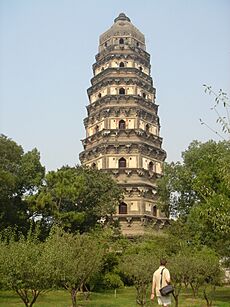
- Opera: Kunqu opera started in the Suzhou region. The newer Suzhou Opera also comes from here. Ballad-singing, or Suzhou pingtan, is a local way of telling stories. It mixes singing with spoken parts.
- Silk: For a long time in China's history, Suzhou silk was known for being very high quality. It was used by ancient royal families. By the 13th century, Suzhou was already the center of the silk trade.
- Song Brocade: Suzhou Song-style brocade is one of China's three most famous brocades. It is made of silk and has a thin but strong material. It has bright colors, beautiful patterns, and a soft feel. Suzhou has been making brocade since the Five Dynasties period. It became very popular during the Song dynasty.
- Cuisine: Suzhou cuisine is part of Jiangsu cuisine. Famous dishes include Yangcheng Lake large crab and Squirrel fish.
- Handicrafts: Suzhou is known for many handicrafts. These include Suzhou embroidery, fans, Chinese musical instruments, scroll mounting, lanterns, mahogany furniture, jade carving, and silk tapestry. Traditional painting pigments and New Year's wood-block prints also come from here.
- Paintings: The city has a rich history of paintings.
- Calligraphy: Calligraphic art is also important in Suzhou.
- Suzhou Silk Hand Embroidery Art: This is a special type of embroidery.
- Music: Suzhou is the original place of the song "Jasmine." This song has been sung many times at important events. Jasmine is a symbol of Suzhou and Lake Tai.
- Suzhou Gardens: Gardens in Suzhou have a very old history. The first garden belonged to the emperor of Wu State around 600 BC. Between the 16th and 18th centuries, there were more than 200 gardens in Suzhou. Suzhou gardens are designed to look like Chinese paintings. Each view in a garden can be seen as a painting. The whole garden is like a huge Chinese painting. The Humble Administrator's Garden, built in the 16th century, is the largest private garden in Suzhou.
- Embroidery: Suzhou embroidery is one of the "Four Famous Embroideries" of China. It is recognized as a cultural heritage.
- Suzhou Museum: The Suzhou Museum has many old items from different times. These include records, stone carvings, folk customs, and Buddhist artifacts.
- Wedding Gowns: Suzhou is also known for its wedding gowns.
Famous People from Suzhou
- Lu Xun (183–245): A military general and politician.
- Feng Menglong (1574–1645): A famous writer and poet from the late Ming dynasty.
- Tang Yin (1470–1524): One of China's most famous painters, also a calligrapher and poet.
- Wen Zhengming (1470–1559): A painter and poet of the Ming dynasty. He started the Wu School of painting.
- Weng Tonghe (1830–1904): A scholar and teacher to emperors in the late Qing dynasty.
- I. M. Pei (1917–2019): One of China's best architects. He designed the Louvre Pyramid and the Hong Kong Bank of China tower.
- Cheng Kaijia (1918–2018): A nuclear physicist and engineer. He was key in China's nuclear weapons program.
- Tsung-Dao Lee (1926–2024): A physicist who won the Nobel Prize in Physics in 1957.
Education in Suzhou
Universities and Colleges: Higher Learning
- Changshu Institute of Technology
- Duke Kunshan University
- KEDGE Business School
- Jiangnan Social University
- Jiangsu University Zhangjiagang Campus
- Renmin University of China Suzhou Campus
- Skema Business School – a French business school campus
- Soochow University
- Suzhou Polytechnic Institute of Agriculture
- Suzhou University of Science and Technology
- Xi'an Jiaotong-Liverpool University
- Suzhou City University
Universities Being Built
- Nanjing University Suzhou Campus
- Northwestern Polytechnical University Taicang Campus
High Schools: Preparing for College
- Changshu High School
- Dulwich College Suzhou
- Dulwich International High School Suzhou
- Kunshan Senior High School
- SIP Experimental Middle School
- Suzhou Experimental High School
- Suzhou High School
- Suzhou Singapore International School
- Suzhou No.1 High School
- Suzhou No.10 High School
- Suzhou Wuxian High School (苏州吴县中学)
- Taicang Senior High School
- United World College (UWC) Changshu China
- Zhenze Middle School
- Jiangsu Province Mudu senior High School
Postgraduate Institutions: Advanced Studies
- Southeast University-Monash University Joint Graduate School
- Suzhou Dushu Lake Higher Education Town (includes branches of National University of Singapore and Nanjing University)
Other Schools
- Japanese School of Suzhou
- Overseas Chinese Academy Chiway Suzhou (苏州工业园区海归人才子女学校)
See also
 In Spanish: Suzhou para niños
In Spanish: Suzhou para niños







